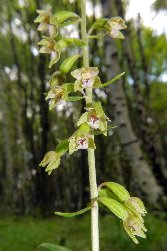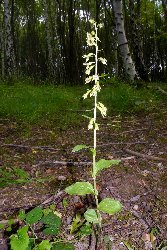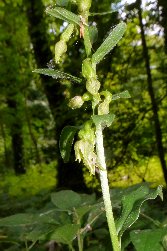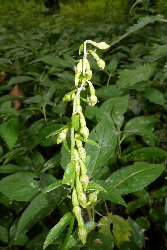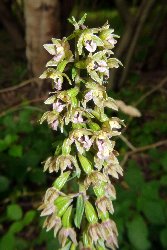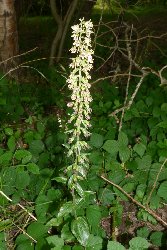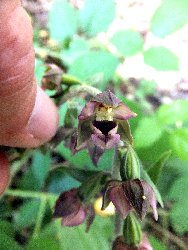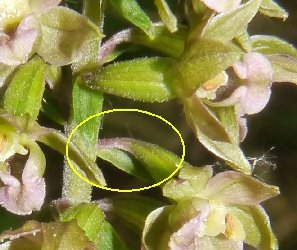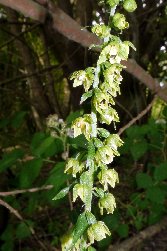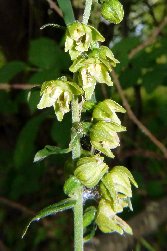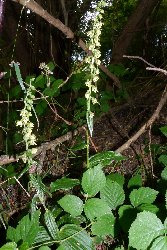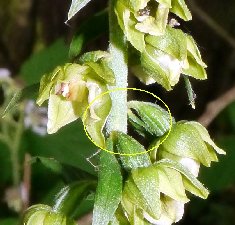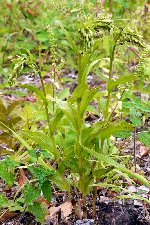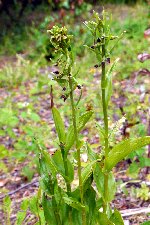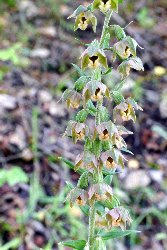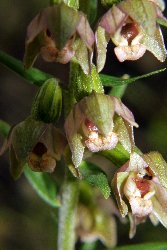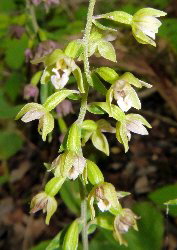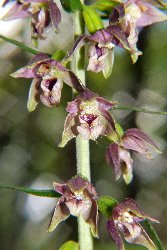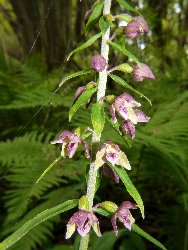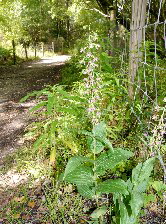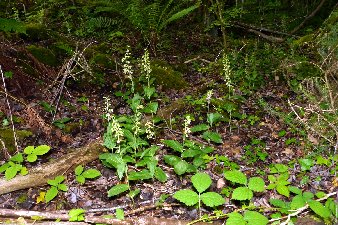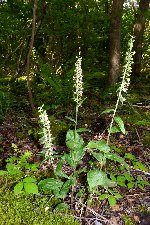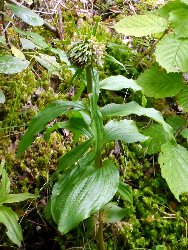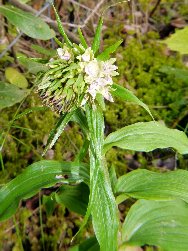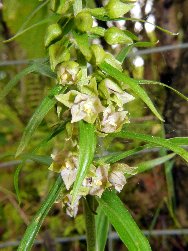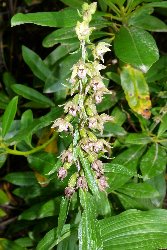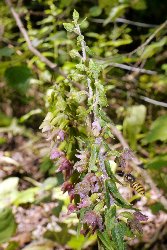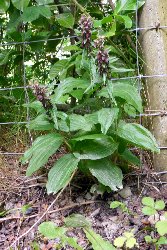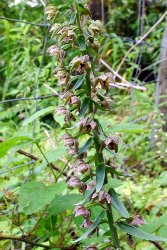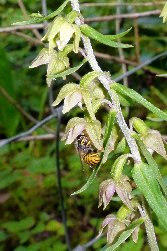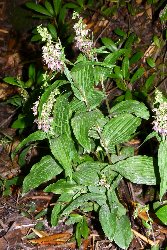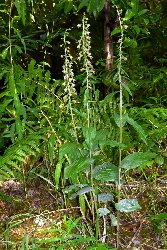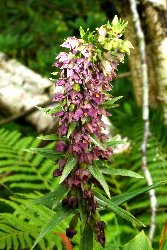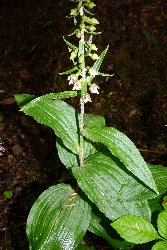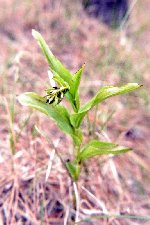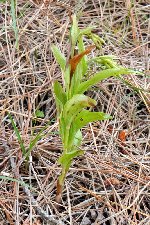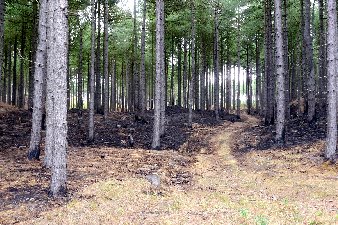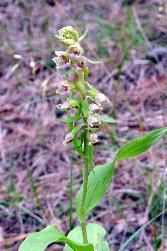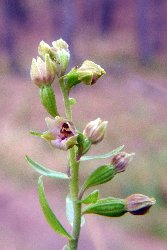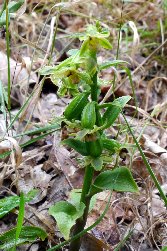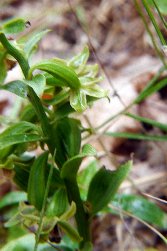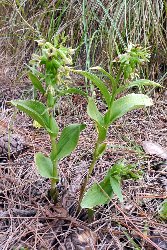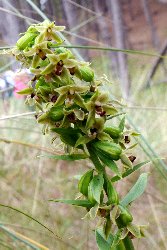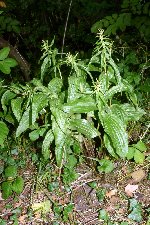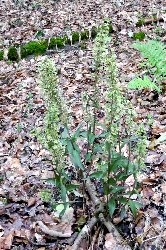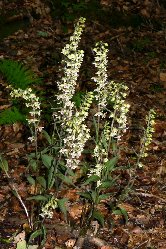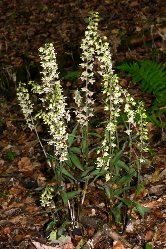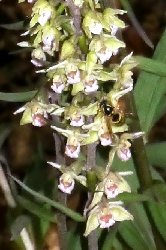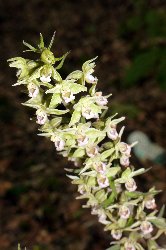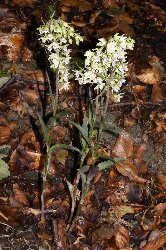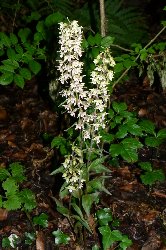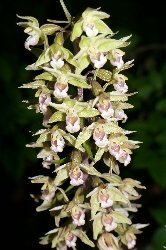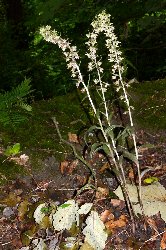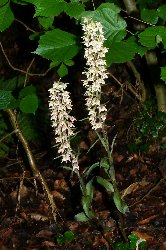|
|
|||||||||||||||||
|
|
|||||||||||||||||
 |
|
Alyn Waters Country Park 15th July 2018 (SJ 31995 54686) We are here with two missions to achieve. The first is to locate a pair of Epipactis hybrids in the woods. I do have locations, marked on an aerial image, and directions, but it is a needle-in-a-haystack situation. One should have been obvious, but there is some rabbit damage at the spot and I suspect what I am looking for is now represented by a leaf-less, flower-less stalk. Still the Dune Helleborines are not bad, in flower and relatively numerous. I think they benefitted from the heavy shower that passed Wrexham two days previously. The Green-flowered Helleborines are also numerous, but still mostly in tight bud. The second mission is to find Broad-leaved Helleborines, and I do have good directions for these too. They are on the Llay side of the park near the visitor centre. Luckily we can go straight to them. What is more, two just do not look right to me. Yes there are typical BLH, but also two rather tall flowering spikes. The second plant has very pale flowers, almost as pale as E. helleborine Var. viridifora. Again the stem is not particularly hairy and the pedicles are untwisted. Again the leaves are opposite each other. What drew my attention was that the flowers were not opening wide, and the back of the sepals really resemble those on the local Green-flowered Helleborines. Thus E. helleborine x phyllanthes or even E. dunensis x phyllanthes are possibilities for me. However there is one other feature on this plant. The unfurled flower buds are almost spherical. Epipactis buds are typically and nearly always pointed to an extent. I have seen spherical buds before; on the mutant plants BLH at Nant-y-Ffrith which have multiple reproductive structures. There is no evidence for that or similar abnormalities here though. I put the pictures on social media for the online experts to look at, and the unequivocal opinion was Broad-leaved Helleborine for both of these plants. Whilst they may have seen more Epipactis than me, they have not seen these in the flesh so to speak; and what are often claimed to be diagnostic features for identification of Epipactis species seem to not count for much on these plants. Unfortunately my camera is not good for the leaf margin microdetail that is vogue these days. I am going to stick my neck out on these and hopefully someone else will see them and come to similar conclusions. Marford Quarry 16th July 2018 (SJ356560) The rain that hit Alyn Waters must have gone around this quarry. The Dune Helleborines and the Green-flowered Helleborines all have blackened flowers and will not be showing this year. Minera Lead Mines 17th July 2018 (SJ2751450929) The displays of Broad-leaved Helleborines here shame those I've seen (or not managed to find) in some of the well-known reserves down south that receive accolades. They are here in huge numbers, and present with a range of colours. Some have colouring that I have not seen elsewhere. This includes plants with sepals that are violet-green on the back and pale yellow on the inside, and others with an orangish colour to the lips. Along the old railway trackbed there is a patch where some seem to have a mutation in which the flowers are largely upside down. They stand out because the yellow pollinia are now exposed and obvious, but left intact possibly because pollinators will not land on the lip in traditional manner. The most extreme example of this has all the flowers compressed into a tight ball - fasciation is the correct term for this phenomenon. They are only just beginning to open, but it will be quite a sight when more are out. Nant-y-Ffrith, Bwlchgwyn 21st and 26th July 2018 (SJ26395392) The Broad-leaved Helleborines here are only just starting to open. Don't forget that they are growing at 300 metres altitude, so no surprises; The Common Spotted Orchids can still be seen only just beginning to go over. The numbers of BLH are still good, and despite the recent weather, perhaps only 2% look to be affected. It is cool and damp up here. Newborough Forest 22nd July 2018 (SH 40552 63432) This is perhaps the longest and most pointless outing of 2018. I doubt a single Dune Helleborine will actually succeed in showing an open flower. The problem is that this is quite a large expanse of pine and dune habitat, and we only cover the one same small area each visit. Perhaps we should venture somewhere totally new next time, at risk of seeing nothing. Ainsdale Woods 23rd July 2018 (SD2996111219) The big news here is that the heat and drought resulted in a fire in the pine trees, reported in the Daily Telegraph and many of the more local press. We soon come to where the fire was (or at lest one of the fires) and though extensive it really does look like little permanent damage has been done. The fire seems to be been restricted to the pine needles, pine cones and dry dead vegetation on the ground; simple fire breaks and paths stopped it spreading too far. Hopefully, this will actually reboot the annuals and the orchids here, having cleared some undergrowth.
There is a mixed picture here, with regard to the dry weather. A couple of heavy showers may have been fortuitously timed to save some orchids, but still about half the Dune Helleborines and Green-flowered Helleborines won't flower. But, that means half have and already there are swollen seed-filled ovaries developing. On the way back, Taking more photos, one plant catches my eye. It is growing between the area where the Dune Helleborines and the Green-flowered Helleborines grow. Is this an inadvertent clue? For a Green -flowered Helleborine the flowers are remarkably wide open and undrooping, but is clearly not a Dune Helleborine. The ovary pedicles are untwisted (a Dune feature) but the base of the stalk is green (Green-flowered). The sepals have that two-tone colouration, but the lip has a pinkish tinge, especially on those flowers that are on their way out. Is this purely because of that or is this a hybrid. Certainly the two speciees grow and flower together, and despite both being autogamous I have seen both species being visited by insects such as soldier beetles. I will cautiously accept it as a hybrid! Tanyfron, Wrexham 26th July 2018 (SJ 29276 52177) Having had a tip off about an orchid sighting, and because it was only a mile off our route home from Nant-y-Ffrith, we called in to what was once the site of Vron Colliery, though there is little evidence of its previous use. Sure enough there is a clump of seven flowering spikes, sadly brought to an early termination due to the weather, but worth a visit next year. A couple of other mature plants are seen nearby, plus a few youngsters suggesting this is a developing colony. More could be found.
One of my first Orchid books was Wild Orchids of Britain by Summerhayes. There is a plate of a clump of Violet Helleborines on a Hampshire roadside, and I often dreamt of finding similar. Today I find a clump that is nearly twice the size of that, with thirteen pikes. Incredibly, I walked past it going up a woodland slope, and only spot it as I come back down, such is the overall pallor of the plant. Normal photography does not do it justice, but a bit of flash can reveal it better. Admitedly, it is a bit untidy, but who cares! Certainly not the wasps feeding there. None are carrying pollinia suggesting that most, if not all, of the flowers have already been visited and presumably fertilised.
Apart from the Var rosea at this site, which has shriveled and dried out, 2018 seems to be a good year for Violet Helleborines. Apart from the clump, I count 21 others on the west side of the valley and 20 on the other side, with many of a good height, and with many flowers. There are nice single plants, pairs and triplets. The weather must have been perfect for them at key points in the flower development. Do Violet Helleborines 'move' from year to year? We have visited this site every year for some 5 years and seen the same plants in flower. When we first saw this particular pair in the last photo they were hidden behind the hazel, which had to be held back for photography. Now they are well in front of the hazel, and close to path edge. They are in danger of being trodden on. It looks like these and others are creeping forwards year after year, and what were unobvious a few years back are now blindingly obvious.
|
|
|
||||||||||||||
